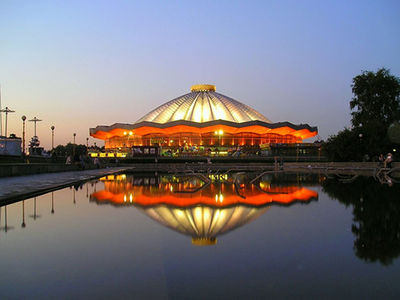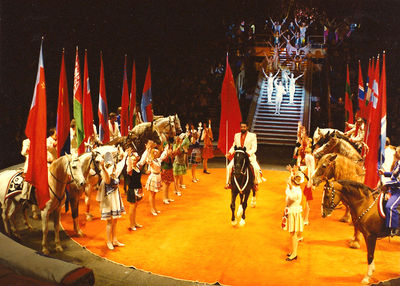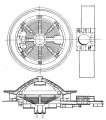Difference between revisions of "Bolshoi Circus"
From Circopedia
(→Moscow's "New Circus") |
(→A Revolutionary Building) |
||
| (6 intermediate revisions by the same user not shown) | |||
| Line 4: | Line 4: | ||
| − | [[File:Bolshoi_Circus_by_night.jpeg|right|thumb|400px|The Bolshoi Circus]]The "Great Moscow Circus on Vernadsky Avenue" (''Большой Московский цирк на проспекте Вернадского'' in Russian) was built under the tenure of Leonid Brezhnev as First Secretary of the Communist Party of the USSR, and opened its doors on April 30, 1971. | + | [[File:Bolshoi_Circus_by_night.jpeg|right|thumb|400px|The Bolshoi Circus]]The "Great Moscow Circus on Vernadsky Avenue" (''Большой Московский цирк на проспекте Вернадского'' in Russian), better known as Moscow's ''Bolshoi Circus'' ("Great Circus") was built under the tenure of Leonid Brezhnev as First Secretary of the Communist Party of the USSR, and opened its doors on April 30, 1971. It is located on Vorobiovy Hills (formerly Lenin Hills), in the Gagarin District, between Vernadsky Prospect (avenue), which separates it from the Moscow University campus, and Nikolai Kopernik (Copernic) Street, and Lomonosov Avenue, which joins them on the southern side. Although it is far from Moscow's center, it is well deserved by the ''Universitet'' metro station. |
| − | + | ===A Revolutionary Building=== | |
| − | + | The building was conceived by Yakov Borisovich Belopolsky (1916-1993)—one of the busiest official architects of the Brezhnev era—in cooperation with E. Bulikh, S. Feoktistov and V. Khavin, the engineers who developed the unique technology of this revolutionary circus. With its 3,350-seat house, 56 meters in diameter (approximately 185 feet) and a height of 28 meters (92 feet) under the cupola, and its numerous specialized features and facilities, it is the world's largest and technically most advanced circus building. | |
| − | + | Its unique fittings make it an exceptional tool for the presentation of all sorts of large-scale circus productions. The ensemble includes a rehearsal ring, located backstage behind the ring entrance in a space vast and high enough to accommodate aerial acts; a stage above the ring entrance, which can connect to the ring with a telescopic staircase that unfolds automatically; the possibility for aerialists and technicians to access the house or their apparatus from the ceiling; a multitude of dressing rooms, offices, and workshops (for costumes and equipment), a canteen and a cafeteria for the personnel, and several spacious rooms with controlled temperatures to accommodate the upkeep of all sorts animals. | |
| − | + | But the true jewel of the crown is without a doubt its interchangeable ring: It is placed on a hydraulic circular platform that can be lowered into a gigantic basement, where four other full-size specialized rings are stored around this central elevator, and can roll on and off its platform. The main ring is a traditional equestrian ring, the first ever to have been covered with a hard-rubber mat, as it is now the custom in Russian circuses. Others are: A water basin, replete with underwater lighting and fountains; a hard floor ring with trapdoors for magic acts; a lighted floor ring with color effects; and an ice ring. This system allows not only quick floor changes adapted to each specific act, but also gives the possibility to install complicated rigging or scenic elements during the presentation of an aerial act or of an act on stage. | |
| − | The | + | ===The Rise and Fall of The Soviet Circus's Flagship=== |
| − | + | During the Communist era, the Bolshoi Circus was the most prestigious circus of the USSR. From 1977-1983, it was under the management of the famous antipodist (foot juggler—and, in this case, ladder balancer) [[Evgeniy Milaev]] (1911-1983), who had been be Leonid Brezhnev's daughter's first husband. After a financial scandal that implied Milaev, followed by his death in 1983, the circus passed under the management of another former star of the Soviet circus, the perch-pole balancer [[Leonid Kostiuk]]. Kostiuk remained at the helm until the fall of the Soviet regime in 1991. [[Image:Bolshoi_Circus_Parade_1976.jpg|left|thumb|400px|Inside the Bolshoi Circus (1976)]] | |
| − | + | After the fall of the USSR, and without the communist system of corporate group sales, it became difficult to fill to capacity the 3,550 seats of a circus that was particularly expensive to maintain. During the Yeltsin era, which was particularly disastrous for Russia, the circus was managed by a string of bureaucrats with no real artistic or administrative competence, and the circus began to face serious financial problems and it fell in a state of disrepair. In the process, the Bolshoi Circus's old downtown competition, "The Circus on Tsvetnoy Boulevard" (today [[Circus Nkulin]]), which had been entirely rebuilt in the mid-1980s, reclaimed its crown as Moscow's—and Russia's—premier circus. | |
| − | In 2018, the circus left the Ministry of Culture and passed under the control of the City of Moscow, which immediately decided to undergo a complete makeover of its aging structure, which, in spite of recent renovations and modernization, was still in poor condition: leaking roofs, particularly, had to be addressed. It was a good move for the Bolshoi Circus, since the rich and vibrant City of Moscow can put more attention on the well-being of its giant circus. | + | In 2012, however, a change of administrative management at the Bolshoi Circus marked the dawn of a new era, and it came with the beginning of a long-awaited restoration. In 2013, the Russian Ministry of Culture renewed its interest in the circus arts; this led to major changes in the management of [[RosGosTsirk]], the Russian circus central organization, and at the Bolshoi Circus, which was a State circus (and thus under the direct purview of the Ministry of Culture). Its management was given to the brothers [[The Zapashny Family|Edgard and Askold Zapashny]], who already owned a private (and extremely successful) circus company and had proved their worth. |
| + | |||
| + | ==The Renaissance== | ||
| + | |||
| + | The best known circus artists in Russia, and the wealthiest to boot, the brothers Zapashny did not see the Bolshoi Circus as a mean to make more money: they claimed that they approached its management as a "patriotic" duty—the restoration of its primary position in the Russian circus, and in the circus world in general. In 2013, they created the "[[Idol Festival|Idol" World Festival of Circus Arts, which immediately became a major international circus event, putting the Bolshoi Circus back on the international map. They also started an extensive program of renovation of the building and its aging machinery, and they brought their own creative talents to its productions, which became more attuned to modern audiences. Thus the mighty Bolshoi Circus experienced a renaissance. | ||
| + | |||
| + | In 2018, the circus left the Ministry of Culture and passed under the control of the City of Moscow, which immediately decided to undergo a complete makeover of its aging structure, which, in spite of recent renovations and modernization, was still in poor condition: leaking roofs, particularly, had to be addressed. It was a good move for the Bolshoi Circus, since the rich and vibrant City of Moscow can put more attention on the well-being of its giant circus. It is now thriving again, and one of the leading circuses of the World. | ||
==Image Gallery== | ==Image Gallery== | ||
Revision as of 00:54, 14 May 2021
Moscow's "New Circus"
By Dominique Jando
A Revolutionary Building
The building was conceived by Yakov Borisovich Belopolsky (1916-1993)—one of the busiest official architects of the Brezhnev era—in cooperation with E. Bulikh, S. Feoktistov and V. Khavin, the engineers who developed the unique technology of this revolutionary circus. With its 3,350-seat house, 56 meters in diameter (approximately 185 feet) and a height of 28 meters (92 feet) under the cupola, and its numerous specialized features and facilities, it is the world's largest and technically most advanced circus building.
Its unique fittings make it an exceptional tool for the presentation of all sorts of large-scale circus productions. The ensemble includes a rehearsal ring, located backstage behind the ring entrance in a space vast and high enough to accommodate aerial acts; a stage above the ring entrance, which can connect to the ring with a telescopic staircase that unfolds automatically; the possibility for aerialists and technicians to access the house or their apparatus from the ceiling; a multitude of dressing rooms, offices, and workshops (for costumes and equipment), a canteen and a cafeteria for the personnel, and several spacious rooms with controlled temperatures to accommodate the upkeep of all sorts animals.
But the true jewel of the crown is without a doubt its interchangeable ring: It is placed on a hydraulic circular platform that can be lowered into a gigantic basement, where four other full-size specialized rings are stored around this central elevator, and can roll on and off its platform. The main ring is a traditional equestrian ring, the first ever to have been covered with a hard-rubber mat, as it is now the custom in Russian circuses. Others are: A water basin, replete with underwater lighting and fountains; a hard floor ring with trapdoors for magic acts; a lighted floor ring with color effects; and an ice ring. This system allows not only quick floor changes adapted to each specific act, but also gives the possibility to install complicated rigging or scenic elements during the presentation of an aerial act or of an act on stage.
The Rise and Fall of The Soviet Circus's Flagship
During the Communist era, the Bolshoi Circus was the most prestigious circus of the USSR. From 1977-1983, it was under the management of the famous antipodist(French: Antipodiste, Russian: Antipod) Foot juggler. (foot juggler—and, in this case, ladder balancer) Evgeniy Milaev (1911-1983), who had been be Leonid Brezhnev's daughter's first husband. After a financial scandal that implied Milaev, followed by his death in 1983, the circus passed under the management of another former star of the Soviet circus, the perch-poleLong perch held vertically on a performer's shoulder or forehead, on the top of which an acrobat executes various balancing figures. balancer Leonid Kostiuk. Kostiuk remained at the helm until the fall of the Soviet regime in 1991.After the fall of the USSR, and without the communist system of corporate group sales, it became difficult to fill to capacity the 3,550 seats of a circus that was particularly expensive to maintain. During the Yeltsin era, which was particularly disastrous for Russia, the circus was managed by a string of bureaucrats with no real artistic or administrative competence, and the circus began to face serious financial problems and it fell in a state of disrepair. In the process, the Bolshoi Circus's old downtown competition, "The Circus on Tsvetnoy Boulevard" (today Circus Nkulin), which had been entirely rebuilt in the mid-1980s, reclaimed its crown as Moscow's—and Russia's—premier circus.
In 2012, however, a change of administrative management at the Bolshoi Circus marked the dawn of a new era, and it came with the beginning of a long-awaited restoration. In 2013, the Russian Ministry of Culture renewed its interest in the circus arts; this led to major changes in the management of RosGosTsirk, the Russian circus central organization, and at the Bolshoi Circus, which was a State circus (and thus under the direct purview of the Ministry of Culture). Its management was given to the brothers Edgard and Askold Zapashny, who already owned a private (and extremely successful) circus company and had proved their worth.
The Renaissance
The best known circus artists in Russia, and the wealthiest to boot, the brothers Zapashny did not see the Bolshoi Circus as a mean to make more money: they claimed that they approached its management as a "patriotic" duty—the restoration of its primary position in the Russian circus, and in the circus world in general. In 2013, they created the "[[Idol Festival|Idol" World Festival of Circus Arts, which immediately became a major international circus event, putting the Bolshoi Circus back on the international map. They also started an extensive program of renovation of the building and its aging machinery, and they brought their own creative talents to its productions, which became more attuned to modern audiences. Thus the mighty Bolshoi Circus experienced a renaissance.
In 2018, the circus left the Ministry of Culture and passed under the control of the City of Moscow, which immediately decided to undergo a complete makeover of its aging structure, which, in spite of recent renovations and modernization, was still in poor condition: leaking roofs, particularly, had to be addressed. It was a good move for the Bolshoi Circus, since the rich and vibrant City of Moscow can put more attention on the well-being of its giant circus. It is now thriving again, and one of the leading circuses of the World.








